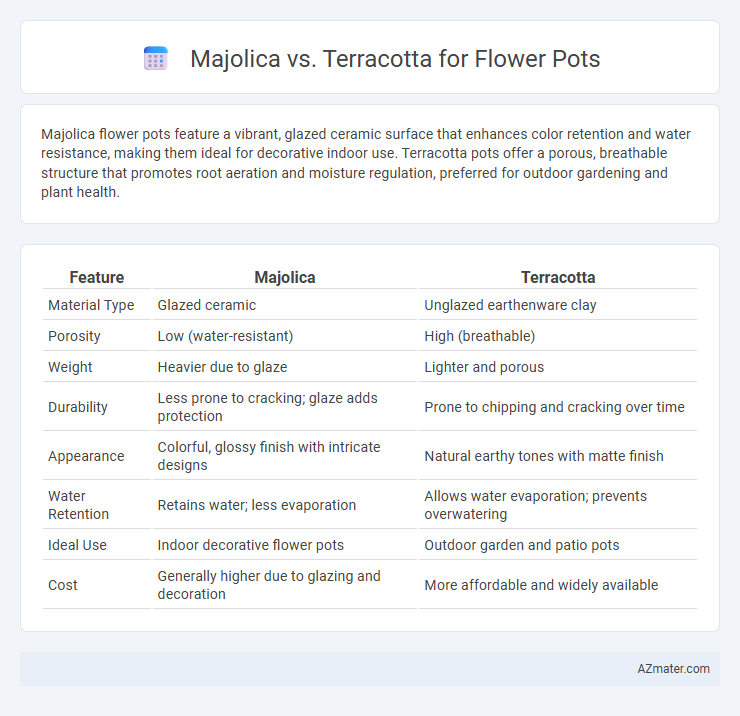Majolica flower pots feature a vibrant, glazed ceramic surface that enhances color retention and water resistance, making them ideal for decorative indoor use. Terracotta pots offer a porous, breathable structure that promotes root aeration and moisture regulation, preferred for outdoor gardening and plant health.
Table of Comparison
| Feature | Majolica | Terracotta |
|---|---|---|
| Material Type | Glazed ceramic | Unglazed earthenware clay |
| Porosity | Low (water-resistant) | High (breathable) |
| Weight | Heavier due to glaze | Lighter and porous |
| Durability | Less prone to cracking; glaze adds protection | Prone to chipping and cracking over time |
| Appearance | Colorful, glossy finish with intricate designs | Natural earthy tones with matte finish |
| Water Retention | Retains water; less evaporation | Allows water evaporation; prevents overwatering |
| Ideal Use | Indoor decorative flower pots | Outdoor garden and patio pots |
| Cost | Generally higher due to glazing and decoration | More affordable and widely available |
Introduction to Majolica and Terracotta Flower Pots
Majolica flower pots are glazed ceramic containers characterized by their vibrant, glossy finish and intricate hand-painted designs, making them ideal for decorative garden display. Terracotta pots are unglazed, porous clay vessels known for their natural reddish-brown color and excellent breathability, which supports healthy root development. Both materials offer distinct aesthetic and functional benefits, with Majolica providing artistic appeal and Terracotta ensuring optimal plant aeration.
Composition and Material Differences
Majolica flower pots are crafted from terra cotta clay coated with a tin-based glaze, which creates a bright, glossy, and waterproof surface ideal for decorative use. Terracotta pots are made from natural, unglazed clay that is porous, allowing air and moisture to penetrate, which benefits plant root health but requires more frequent watering. The primary material difference lies in majolica's glazed finish offering enhanced durability and vibrant color options, whereas terracotta retains a classic, earthy look with superior breathability.
Aesthetic Appeal: Color and Finish
Majolica flower pots feature vibrant, glossy glazes with intricate hand-painted designs, offering a brightly colored and polished finish that enhances visual appeal in gardens and patios. Terracotta pots exhibit a natural, earthy reddish-brown hue with a matte, porous surface that provides a rustic charm and warms outdoor spaces with its subtle texture. The choice between Majolica and Terracotta depends on desired aesthetic impact: Majolica offers bold, artistic color contrasts, while Terracotta delivers a timeless, organic look.
Durability and Weather Resistance
Majolica flower pots feature a glazed surface that enhances durability by providing resistance against moisture, reducing the risk of cracking in wet conditions. Terracotta pots are porous and can absorb water, making them more susceptible to weather-related damage such as frost cracking in freezing temperatures. For long-lasting outdoor use, Majolica offers superior weather resistance compared to the more fragile and porous terracotta material.
Porosity and Plant Health
Majolica flower pots feature a glazed, non-porous surface that retains moisture, reducing the frequency of watering but potentially risking root rot in plants requiring well-drained soil. Terracotta pots are highly porous, allowing air and moisture to pass through the walls, which enhances root aeration and prevents overwatering, promoting healthier plant growth. Choosing between Majolica and Terracotta depends on the specific water needs of the plant and the desired balance between moisture retention and drainage.
Weight and Portability
Majolica flower pots are typically heavier than terracotta due to their glazed ceramic composition, which can affect portability and ease of moving plants. Terracotta pots are lighter and more porous, making them easier to handle and better suited for frequent relocation or outdoor use. The weight difference influences placement options, with terracotta preferred for portability and Majolica chosen for decorative stability.
Cost Comparison: Affordability and Value
Terracotta flower pots generally offer greater affordability compared to majolica, making them a cost-effective choice for budget-conscious gardeners. While majolica pots often come with higher price tags due to their intricate glazing and decorative appeal, they provide added durability and aesthetic value. Choosing between terracotta and majolica depends on balancing initial cost with long-term value and design preferences.
Maintenance and Cleaning Requirements
Majolica flower pots require gentle cleaning with mild soap and water to preserve their glazed surfaces, avoiding abrasive materials that can scratch or damage the decorative finish. Terracotta pots are porous and necessitate regular scrubbing to remove mineral deposits and prevent mold growth, often benefiting from soaking to loosen dirt. Both materials demand thorough drying after cleaning to maintain durability and prevent cracking, but terracotta generally requires more frequent maintenance due to its absorbent nature.
Environmental Impact and Sustainability
Majolica flower pots, made from glazed ceramics, offer durability and reusability but require high-temperature kiln firing, resulting in significant energy consumption and carbon emissions. Terracotta pots, crafted from natural clay fired at lower temperatures, are biodegradable, porous, and facilitate plant health, making them an eco-friendly choice with a lower environmental footprint. Choosing terracotta supports sustainability through natural material sourcing and end-of-life compostability, whereas majolica's longer lifespan may offset its initial environmental cost over time.
Choosing the Best Option for Your Plants
Majolica flower pots offer glazed, vibrant surfaces that retain moisture better, making them ideal for plants requiring consistent hydration and aesthetic appeal. Terracotta pots provide excellent breathability and natural insulation, promoting healthy root growth for drought-tolerant plants but can dry out quickly in hot climates. Selecting between majolica and terracotta depends on your plant's water needs, local climate, and desired decorative style to ensure optimal growth and soil conditions.

Infographic: Majolica vs Terracotta for Flower pot
 azmater.com
azmater.com